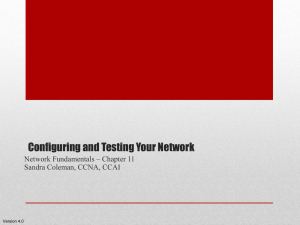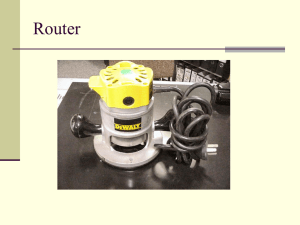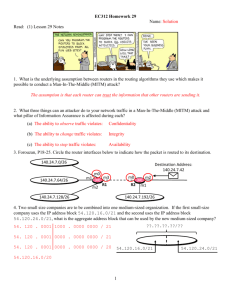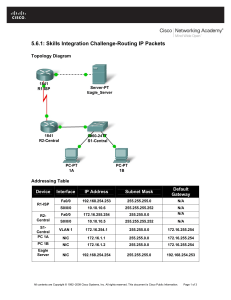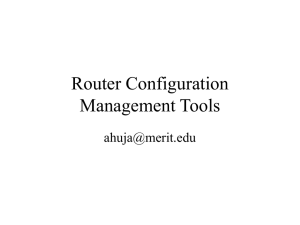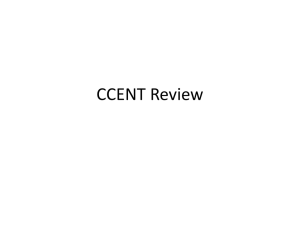Chapter 11
advertisement
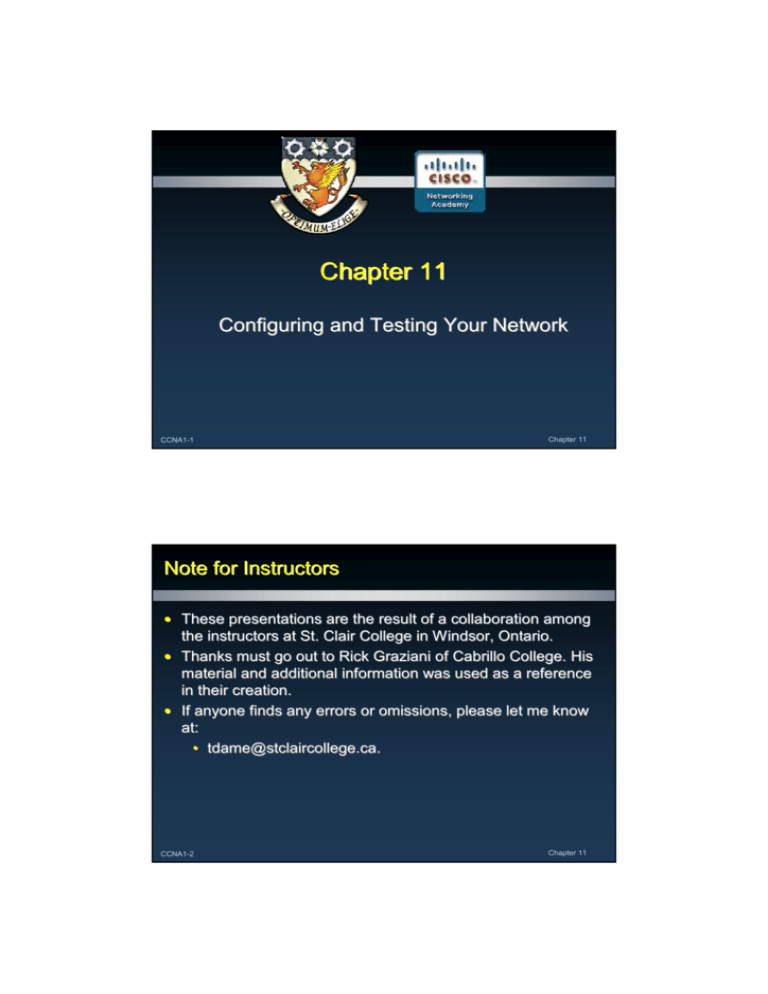
Chapter 11 Configuring and Testing Your Network CCNA1-1 Chapter 11 Note for Instructors • These presentations are the result of a collaboration among the instructors at St. Clair College in Windsor, Ontario. • Thanks must go out to Rick Graziani of Cabrillo College. His material and additional information was used as a reference in their creation. • If anyone finds any errors or omissions, please let me know at: • tdame@stclaircollege.ca. CCNA1-2 Chapter 11 Configuring and Testing Your Network Configuring Cisco Devices: IOS Basics Chapter 11 CCNA1-3 Cisco IOS • As with a computer, a router or switch cannot function without an operating system. • Cisco calls its operating system the Cisco Internetwork Operating System or Cisco IOS. IOS. • The Cisco IOS provides the following network services: • Basic routing and switching functions • Reliable and secure access to networked resources • Network scalability CCNA1-4 Chapter 11 Cisco IOS • The Cisco IOS is accessed using the Command Line Interface (CLI). (CLI). • Features will vary based on the version of the IOS and the type of device. Chapter 11 CCNA1-5 Access Methods Telnet Access Telnet or SSH CCNA1-6 Serial Ports Auxiliary Port Console Port Ethernet Ports Modem Access Terminal Access Telnet Access Chapter 11 Router Components • The main internal components of a router are: • Random Access Memory (RAM) • Nonvolatile Random Access Memory (NVRAM) • Flash Memory (Flash) • Read Only Memory (ROM) • Console • Interfaces Chapter 11 CCNA1-7 Router Components • Random Access Memory (RAM): (RAM): • Stores routing tables • Holds ARP cache • Holds fastfast-switching cache • Performs packet buffering as shared RAM • Maintains packetpacket-hold queues • Provides temporary memory for the configuration file of a router while the router is powered on • Loses content when a router is powered down or restarted CCNA1-8 Chapter 11 Router Components • Nonvolatile Random Access Memory (NVRAM): (NVRAM): • Provides storage for the startup configuration file • Retains content when a router is powered down or restarted Chapter 11 CCNA1-9 Router Components • Flash Memory (Flash): (Flash): • Holds the IOS image • Allows software to be updated without removing and replacing chips on the processor • Retains content when a router is powered down or restarted • Can store multiple versions of IOS software • Is a type of electrically erasable programmable readread-only memory (EEPROM) CCNA1-10 Chapter 11 Router Components • Read Only Memory (ROM): (ROM): • Maintains instructions for powerpower-on self test (POST) diagnostics • Stores the bootstrap program and the basic operating system software • Requires replacing pluggable chips on the motherboard for software upgrades Chapter 11 CCNA1-11 Router Components • Console: • The console port provides physical access for the initial configuration of the router or configuration changes. • Interfaces: • Connect routers to a network for packet entry and exit • They can be on the motherboard or on a separate module CCNA1-12 Chapter 11 Configuration Files • Network devices depend upon two types of software: • Operating system (IOS) • Configuration file Chapter 11 CCNA1-13 Cisco IOS Modes Hierarchical Structure Each mode used to accomplish particular tasks. Each mode has a specific set of commands. CCNA1-14 Chapter 11 Cisco IOS Modes - Routers and Switches Mode Description Prompts User EXEC Limited commands “View Only” Mode Router> Privileged EXEC Configuration commands Debugging and testing File manipulation Router# Global Configuration Commands for the router Entry to other modes Router(config)# Interface Configuration Commands to configure an interface Router(config-if)# Line Configuration Commands to configure console and telnet/ssh access Router(config-line)# Other modes Router(config-mode)# Specific service configuration (NAT / DHCP) Chapter 11 CCNA1-15 Cisco IOS Modes User EXEC Privileged EXEC Global Configuration Interface Configuration CCNA1-16 Chapter 11 Moving Between User and Privileged EXEC • Use enable to move from User to Privileged EXEC. • Use disable or end to move back. Chapter 11 CCNA1-17 Basic IOS Command Structure Router(config)#hostname MyRouter MyRouter(config)# Router(config)#interface fastethernet 0/0 Router(configRouter(config-if)# Router(config-if)# Router(configRouter(config-if)# ip address 192.168.100.1 255.255.255.0 Router(config-if)# Router(configRouter(config-if)# Router(config-if)# CCNA1-18 Chapter 11 Using CLI Help Chapter 11 CCNA1-19 Using CLI Help CCNA1-20 Chapter 11 Using CLI Help • Hot Keys and Shortcuts: • CLI Line Editing: • Several outlined in the text. • Backspace most often used. • Note that the Delete key is NOT recognized to delete invalid characters. Chapter 11 CCNA1-21 Using CLI Help • Hot Keys and Shortcuts: • At the ----More ---- Prompt: ----More---Prompt: • If the screen fills up with a display, the More prompt will be displayed. CCNA1-22 Chapter 11 Using CLI Help • Break Keys: • If you wish to abort a process or command… command….. Chapter 11 CCNA1-23 IOS Examination Commands • In order to verify and troubleshoot network operation, we must examine the operation of the devices. • The basic examination command is the show command. CCNA1-24 Chapter 11 IOS Examination Commands – show version IOS Version, Name RAM INTERFACES FLASH Configuration Register CCNA1-25 Chapter 11 IOS Examination Commands – show flash • Use the show flash command to verify that the router has sufficient memory to load a new Cisco IOS software image. CCNA1-26 Chapter 11 IOS Configuration Modes enable Exit / Ctrl/ Z configure terminal interface / line / router Chapter 11 CCNA1-27 Configuring and Testing Your Network Applying a Basic Configuration CCNA1-28 Chapter 11 Naming Devices • Importance of a Device Name: • Default “Router” Router” or “Switch” Switch” • Host Name appears as the CLI prompt. • Confirmation that the correct device has been accessed. • Naming convention makes maintenance easier. • Start with a letter • No spaces • End with letter or digit • Only letters, digits and dashes • Maximum of 63 characters Chapter 11 CCNA1-29 Naming Devices AtlantaHQ Router> Router>enable Router# Router#configure terminal Router(config)# Router(config)#hostname AtlantaHQ AtlantaHQ(config)# CCNA1-30 Chapter 11 Naming Devices AtlantaHQ Flour_Bluff Switch> Switch>enable Switch# Switch#configure terminal Switch(config)# Switch(config)#hostname Flour_Bluff Flour_Bluff(config)# Chapter 11 CCNA1-31 Limiting Device Access • Configuring Passwords: • Passwords are the primary defense against unauthorized access to network devices. Every device should have locally configured passwords to limit access. • Console password: • Limits device access using the console connection • Enable password: • Limits access to the privileged EXEC mode • Enable secret password: • Encrypted, limits access to the privileged EXEC mode • VTY password: Limits device access using Telnet / SSH CCNA1-32 Chapter 11 Limiting Device Access Chapter 11 CCNA1-33 Limiting Device Access • Encrypting Password Display: • The service passwordpassword-encryption command prevents ALL passwords from showing up as plain text when viewing the configuration files. service passwordpassword-encryption uses a Cisco Level 7 encryption which is very easy to decrypt. CCNA1-34 Chapter 11 Limiting Device Access • www.boson.com Chapter 11 CCNA1-35 Limiting Device Access • www.boson.com Does NOT work for enable secret encryption. CCNA1-36 Chapter 11 Limiting Device Access • Login Banner: Chapter 11 CCNA1-37 Managing Configuration Files running-config (IOS running) startup-config IOS CCNA1-38 Boot Program Chapter 11 Managing Configuration Files No startup-config file in NVRAM Default running-config file, created in RAM Chapter 11 CCNA1-39 Managing Configuration Files running-config resides here startup-config resides here At boot up, running-config is replaced by startup-config…. CCNA1-40 Chapter 11 Managing Configuration Files running-config resides here If the router loses power or reboots, everything in RAM is lost including the running-config file. Changes to the router are automatically put in the running-config file. Chapter 11 CCNA1-41 Managing Configuration Files running-config resides here startup-config resides here To make sure that router changes are saved… copy running-config startup-config CCNA1-42 Chapter 11 Managing Configuration Files The startup-config file is now identical to running-config and the router will have these changes if the router reboots. Chapter 11 CCNA1-43 Managing Configuration Files Router# copy runningrunning-config startupstartup-config OR Router# copy running startup OR Router# copy run start Any usage of the command or parameters, so that they are still uniquely recognizable. CCNA1-44 Chapter 11 Managing Configuration Files - WARNING • Using an incorrect configuration file name could overwrite a file in flash, as the router believes you are trying to copy a blank file into flash. Incorrect destination file name Cancel it with Ctrl-C! Chapter 11 CCNA1-45 Managing Configuration Files • Returning the Device to its Original Configuration: • reload command • Works ONLY IF the running configuration has NOT been copied to the startup configuration. Router# reload System configuration has been modified. Save? [yes/no]: n Proceed with reload? [confirm] Press Enter *Apr 13 01:34:15.758: %SYS%SYS-5-RELOAD: Reload requested by console. Reload Reason: Reload Command. CCNA1-46 Chapter 11 Managing Configuration Files • Backing Up Configurations Offline: • TFTP server • CD • USB Memory Stick • Text Files using the Clipboard. • Text files using HyperTerminal capture. • Restoring Configurations: • TFTP Server • Paste to Host from a text file. Chapter 11 CCNA1-47 Managing Configuration Files (We will be using this TFTP server in the lab on each PC.) • A TFTP server will allow image and configuration uploads and downloads over the network. • The TFTP server can be another router, or it can be a host system. CCNA1-48 Chapter 11 Managing Configuration Files • Once it is installed or before you attempt to use it, ALWAYS make sure that the connectivity is there… there…. Chapter 11 CCNA1-49 Managing Configuration Files What can be copied? CCNA1-50 Chapter 11 Managing Configuration Files • Configuration files can be captured and saved in text format using the text capture function of HyperTerminal (or any other emulator that has the function). Chapter 11 CCNA1-51 Configuring Interfaces Router Interfaces CCNA1-52 Chapter 11 Configuring Interfaces • Configuring a Router Ethernet Interface: Chapter 11 CCNA1-53 Configuring Interfaces • Configuring a Router Serial Interface: CCNA1-54 Chapter 11 Describing Router Interfaces Chapter 11 CCNA1-55 Configuring Interfaces • Configuring a Switch: CCNA1-56 Chapter 11 Configuring and Testing Your Network Verifying Connectivity Chapter 11 CCNA1-57 Test the Stack • PING: • From the command window on a PC. CCNA1-58 Chapter 11 Test the Stack • PING: • From the router IOS. Chapter 11 CCNA1-59 Test the Stack • PING: • Testing the Loopback (127.0.0.1). (127.0.0.1). CCNA1-60 If successful, it means that the protocol stack on the PC is functioning properly from the Network through the Physical Layers. Chapter 11 Testing the Local NIC Assignment Chapter 11 CCNA1-61 Testing the Router Interfaces CCNA1-62 Chapter 11 Testing the Switch Interfaces Chapter 11 CCNA1-63 Testing the Local Network CCNA1-64 Successfully pinging another host on the same subnet verifies that both the local host and the other host are configured correctly. Chapter 11 Testing Gateway Connectivity A successful ping verifies both the host and gateway configurations. Chapter 11 CCNA1-65 Testing Remote Connectivity CCNA1-66 Ping each hop between the local and remote host. Chapter 11 Tracing and Interpreting Trace Results C:\ C:\ping 10.1.0.2 C:\ping Pinging 10.1.0.2 with 32 bytes of data: Request timed out. Problem somewhere past this point. Request timed out. Request timed out. Request timed out. Ping statistics for 10.1.0.2: Packets: C:\>tracert Sent = 4, Received C:\ \>tracert 10.1.0.2 = 0, Lost = 4 (100% loss) C: The pingTracing test failed. route to 10.1.0.2 over a maximum of 30 hops 1 2 ms 2 ms 2 ms 10.0.0.254 2 * * * Request timed out. 3 * * * Request timed out. 4 ^C CCNA1-67 Chapter 11 Configuring and Testing Your Network Monitoring and Documenting Networks CCNA1-68 Chapter 11 Basic Network Baselines • Network Baseline: • Process for studying the network at regular intervals. • Ensure that the network is working as designed. • More than a single report. • Health of the network at a certain point in time. • Accomplished over a period of time. • Varying times and loads will assist in creating a better picture of overall network performance. • Copy and paste the results from an executed ping, trace, or other relevant command into a text file. • Compare the results over time. Chapter 11 CCNA1-69 Basic Network Baselines Run the same test. At different times. Compare the results. CCNA1-70 Chapter 11 Basic Network Baselines • Network Baseline: • Results from a command can be captured and saved as a text file for future study. • PING • TRACEROUTE • CISCO IOS CCNA1-71 Chapter 11 Learning About the Nodes on the Network CCNA1-72 Chapter 11 Ping Sweep / MAC Scanner Tools Chapter 11 CCNA1-73 Switch Connections CCNA1-74 Chapter 11 THE END! CCNA1-75 Chapter 11


